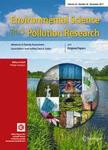版权所有:内蒙古大学图书馆 技术提供:维普资讯• 智图
内蒙古自治区呼和浩特市赛罕区大学西街235号 邮编: 010021

作者机构:Department of Chemical Engineering Faculty of Engineering Minia University Al Minya Egypt Public Works Engineering Department Faculty of Engineering Mansoura University Mansoura35516 Egypt
出 版 物:《Environmental Science and Pollution Research》 (Environ. Sci. Pollut. Res.)
年 卷 期:2024年第31卷第55期
页 面:63977-63992页
核心收录:
学科分类:0830[工学-环境科学与工程(可授工学、理学、农学学位)] 070207[理学-光学] 0817[工学-化学工程与技术] 08[工学] 0703[理学-化学] 0702[理学-物理学]
基 金:The last author acknowledges the support from the Research Fund of Mansoura University by the project No MU-ENG-22-13. He is also supported by an internal research support of the Faculty of Engineering Mansoura University.The last author is supported by a research project by the Research Support Fund of Mansoura University No (MU-ENG-22\u201313) and by an internal research support of the Faculty of Engineering at Mansoura University
主 题:Fourier transform infrared spectroscopy
摘 要:Pharmaceuticals and personal care products (PPCPs) are prevalent emerging pollutants in the aquatic environment. The photocatalysis process has proven high efficiency in degrading PPCPs;however, the fate and repercussions of photocatalyst residuals are a major concern. To avoid that, we developed a composite from graphitic carbon nitride/tungsten doped with titanium dioxide (g-C3N4/W-TiO2) and loaded it on polyvinylidene fluoride (PVDF) membranes by the phase-inversion method. X-ray diffraction (XRD), Fourier-transform infrared spectroscopy (FTIR), transmission electron microscopy (TEM), and other different analyses implied the successful synthesis of g-C3N4/W-TiO2 composite and coating on PVDF membranes. A Box–Behnken design (BBD) was used to optimize the operational parameters, including pH, g-C3N4 ratio in the composite, and initial SMZ concentration by the response surface methodology (RSM). The highest SMZ degradation percentage was 98.60% after 240 min of irradiation. Liquid chromatography with tandem mass spectrometry (LC–MS/MS) along with suspect screening was used to identify the intermediate transformation products and propose the SMZ degradation pathway. The loss in membrane activity after five cycles of photocatalytic degradation was about 18%. According to the current study, the photocatalytic membrane g-C3N4/W-TiO2/PVDF is promising for removing sulfonamide antibiotics from wastewater. © The Author(s), under exclusive licence to Springer-Verlag GmbH Germany, part of Springer Nature 2024.